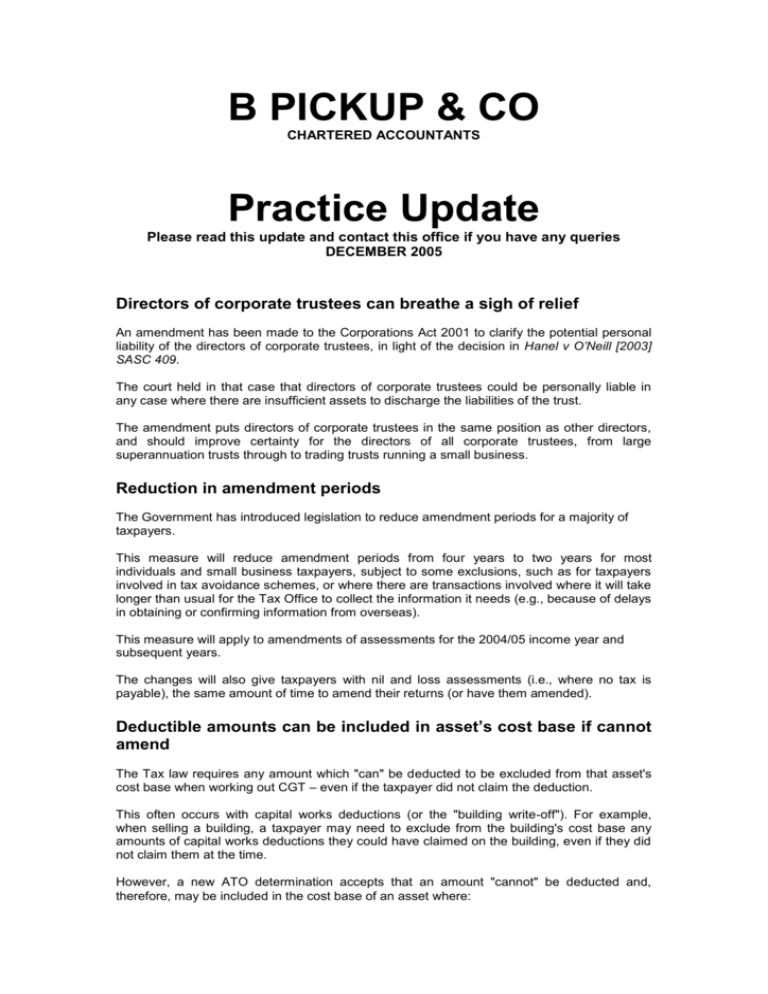dec2005_monthly_newsletter
advertisement

B PICKUP & CO CHARTERED ACCOUNTANTS Practice Update Please read this update and contact this office if you have any queries DECEMBER 2005 Directors of corporate trustees can breathe a sigh of relief An amendment has been made to the Corporations Act 2001 to clarify the potential personal liability of the directors of corporate trustees, in light of the decision in Hanel v O’Neill [2003] SASC 409. The court held in that case that directors of corporate trustees could be personally liable in any case where there are insufficient assets to discharge the liabilities of the trust. The amendment puts directors of corporate trustees in the same position as other directors, and should improve certainty for the directors of all corporate trustees, from large superannuation trusts through to trading trusts running a small business. Reduction in amendment periods The Government has introduced legislation to reduce amendment periods for a majority of taxpayers. This measure will reduce amendment periods from four years to two years for most individuals and small business taxpayers, subject to some exclusions, such as for taxpayers involved in tax avoidance schemes, or where there are transactions involved where it will take longer than usual for the Tax Office to collect the information it needs (e.g., because of delays in obtaining or confirming information from overseas). This measure will apply to amendments of assessments for the 2004/05 income year and subsequent years. The changes will also give taxpayers with nil and loss assessments (i.e., where no tax is payable), the same amount of time to amend their returns (or have them amended). Deductible amounts can be included in asset’s cost base if cannot amend The Tax law requires any amount which "can" be deducted to be excluded from that asset's cost base when working out CGT – even if the taxpayer did not claim the deduction. This often occurs with capital works deductions (or the "building write-off"). For example, when selling a building, a taxpayer may need to exclude from the building's cost base any amounts of capital works deductions they could have claimed on the building, even if they did not claim them at the time. However, a new ATO determination accepts that an amount "cannot" be deducted and, therefore, may be included in the cost base of an asset where: it was an allowable deduction; but the taxpayer is unable to claim the deduction because the period for amending the relevant tax return has expired. However, if the amendment period has not yet expired, the taxpayer is expected to go back and amend the prior return to claim the deduction. “Low doc loan” insurance data matching program The ATO has advised that it will request and collect names and addresses of entities who have taken out insurance on “low doc loans” from the following Australian mortgage insurance providers: Australia and New Zealand Banking Group Ltd (ANZ); G E Mortgage Insurance Company Propriety Ltd; PMI Mortgage Insurance Ltd; St George Bank Ltd; Suncorp-Metway Ltd; and Westpac Banking Corporation. The information obtained will be electronically matched with other data held by the ATO. Super tax savings for 55+ taxpayers The Tax Office has issued a media release which contains a largely unexpected bonus for taxpayers who are still working and over the age of 55. It relates to the Government’s “transition to retirement pensions” measure, which allows taxpayers to draw down from their super fund while continuing to work after they turn 55. The media release accepts that taxpayers will be able to salary sacrifice their salary into their super fund and draw out a pension from the same fund – deferring tax and potentially delivering huge tax savings over time for those who don't need their larger than average income. The Tax Office will only be concerned where accessing the pension or undertaking the salary sacrifice may be artificial or contrived. Example – Pension top-up required Jack is 56 and is on a wage of $100,000. He decides to salary sacrifice $37,000 of his salary into his superannuation fund to bring his salary income down to $63,000 so that his income is taxed at no more than 31.5% ($63,000 is the threshold before the next higher rate of 42% applies). Tax on entry of the contribution into the super fund is 15% of $37,000 or $5,550. However, Jack has more commitments and requires a net after tax income of $54,000, so he needs to draw down a pension of $10,000 (and his super fund allows him to do this). In that case, his tax payable is calculated as follows: Tax on $73,000 (63K + 10K) Plus Medicare Levy Tax & M/Levy $18,960 1,095 $20,055 Less 15% Rebate on pension Tax Payable 1,500 $18,555 Total tax payable: Super fund $5,550 Jack's individual tax 18,555 $24,105 Had Jack received the full $100,000 in his own name, tax payable would have been $32,050. By bringing the tax rate on his earnings down, Jack has been able to leave his tax saving of $7,945 ($32,050 – $24,105) in his super fund. Note: The following should be kept in mind: the above example does not take into account additional costs in the super fund, etc.; employees are entitled to salary sacrifice the whole of their salary; however, employers are only entitled to deductions up to the age based limit. For 55+ taxpayers, the age based limit for 2005/06 is $100,587; the 15% superannuation pension rebate cannot reduce the Medicare levy; superannuation funds that commence paying pensions become exempt from tax on assets supporting the pension ("segregated pension assets"). However, other investment income or contributions are not exempt; and income must be high enough for direct tax savings to occur. However, taxpayers on incomes of less than $63,000 may wish to undertake the above strategy to lock in the value of assets supporting a pension and reduce the tax in their super fund. Also, appreciation in the value of segregated pension assets is ignored for RBL purposes. Editor: Please contact this office if you are interested in discussing the above strategy. Please Note: Many of the comments in this publication are general in nature and anyone intending to apply the information to practical circumstances should seek professional advice to independently verify their interpretation and the information's applicability to their particular circumstances.




